EHR System Development: EIA RA Framework - ATMC ICT705 Report
VerifiedAdded on 2023/06/12
|19
|3291
|176
Report
AI Summary
This report proposes an Enterprise Information Architecture Reference Architecture (EIA RA) approach for developing an electronic health record (EHR) system. It uses various diagrams to illustrate the project's development from start to finish, detailing aspects like conceptual architecture, logical architecture, component relationship, component interaction, and operational model. The report discusses the benefits and challenges of using EIA RA, including integration, interoperability, data domains, and potential barriers related to cost, expertise, and system learning. It concludes by suggesting strategies to mitigate the limitations and improve the effectiveness of implementing an EHR system using the EIA RA framework, emphasizing the importance of stakeholder involvement, resource allocation, and proactive risk management.

EHR system using EIA RA
Name of the Student
Name of the University
Authors Note
Name of the Student
Name of the University
Authors Note
Paraphrase This Document
Need a fresh take? Get an instant paraphrase of this document with our AI Paraphraser
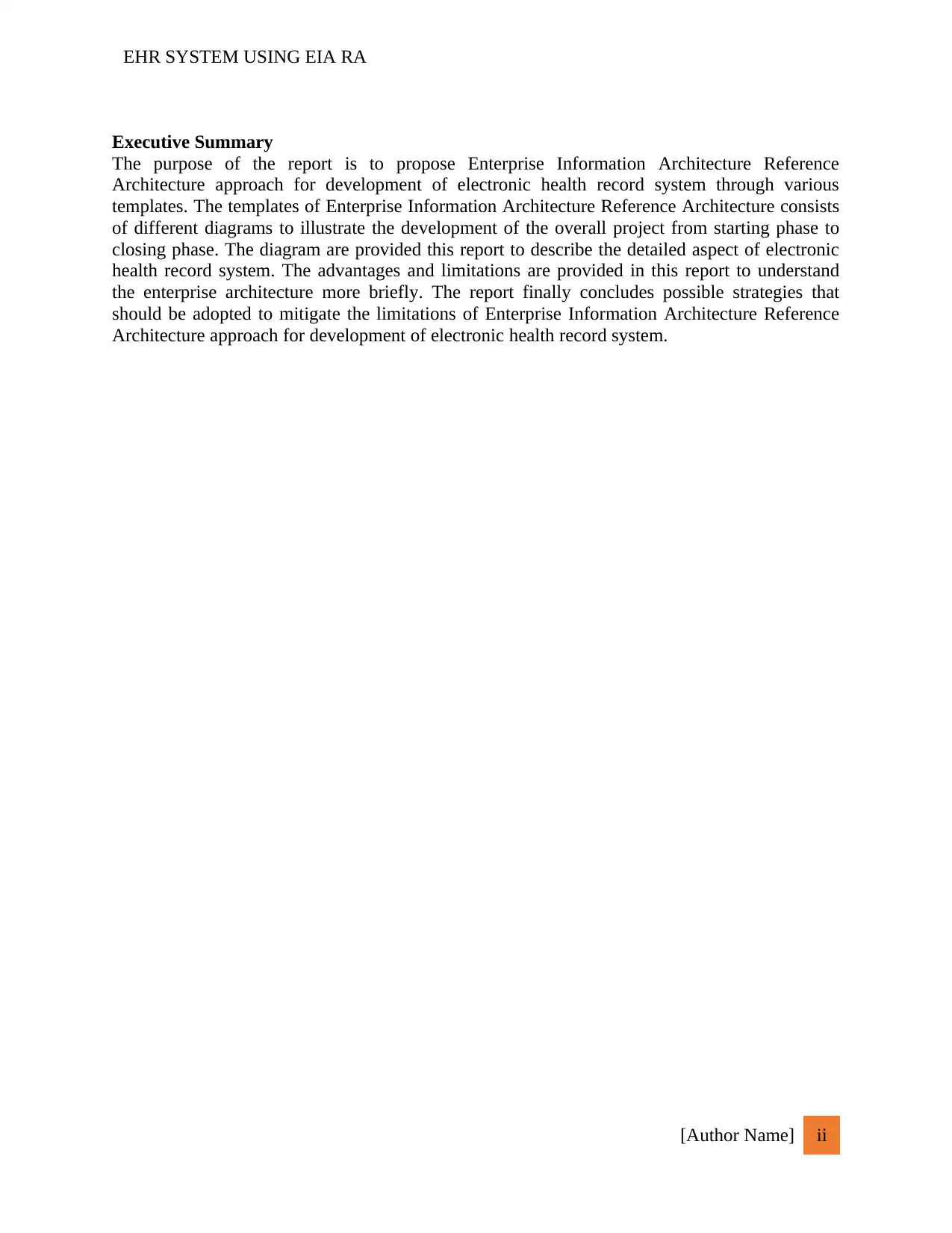
EHR SYSTEM USING EIA RA
Executive Summary
The purpose of the report is to propose Enterprise Information Architecture Reference
Architecture approach for development of electronic health record system through various
templates. The templates of Enterprise Information Architecture Reference Architecture consists
of different diagrams to illustrate the development of the overall project from starting phase to
closing phase. The diagram are provided this report to describe the detailed aspect of electronic
health record system. The advantages and limitations are provided in this report to understand
the enterprise architecture more briefly. The report finally concludes possible strategies that
should be adopted to mitigate the limitations of Enterprise Information Architecture Reference
Architecture approach for development of electronic health record system.
[Author Name] ii
Executive Summary
The purpose of the report is to propose Enterprise Information Architecture Reference
Architecture approach for development of electronic health record system through various
templates. The templates of Enterprise Information Architecture Reference Architecture consists
of different diagrams to illustrate the development of the overall project from starting phase to
closing phase. The diagram are provided this report to describe the detailed aspect of electronic
health record system. The advantages and limitations are provided in this report to understand
the enterprise architecture more briefly. The report finally concludes possible strategies that
should be adopted to mitigate the limitations of Enterprise Information Architecture Reference
Architecture approach for development of electronic health record system.
[Author Name] ii
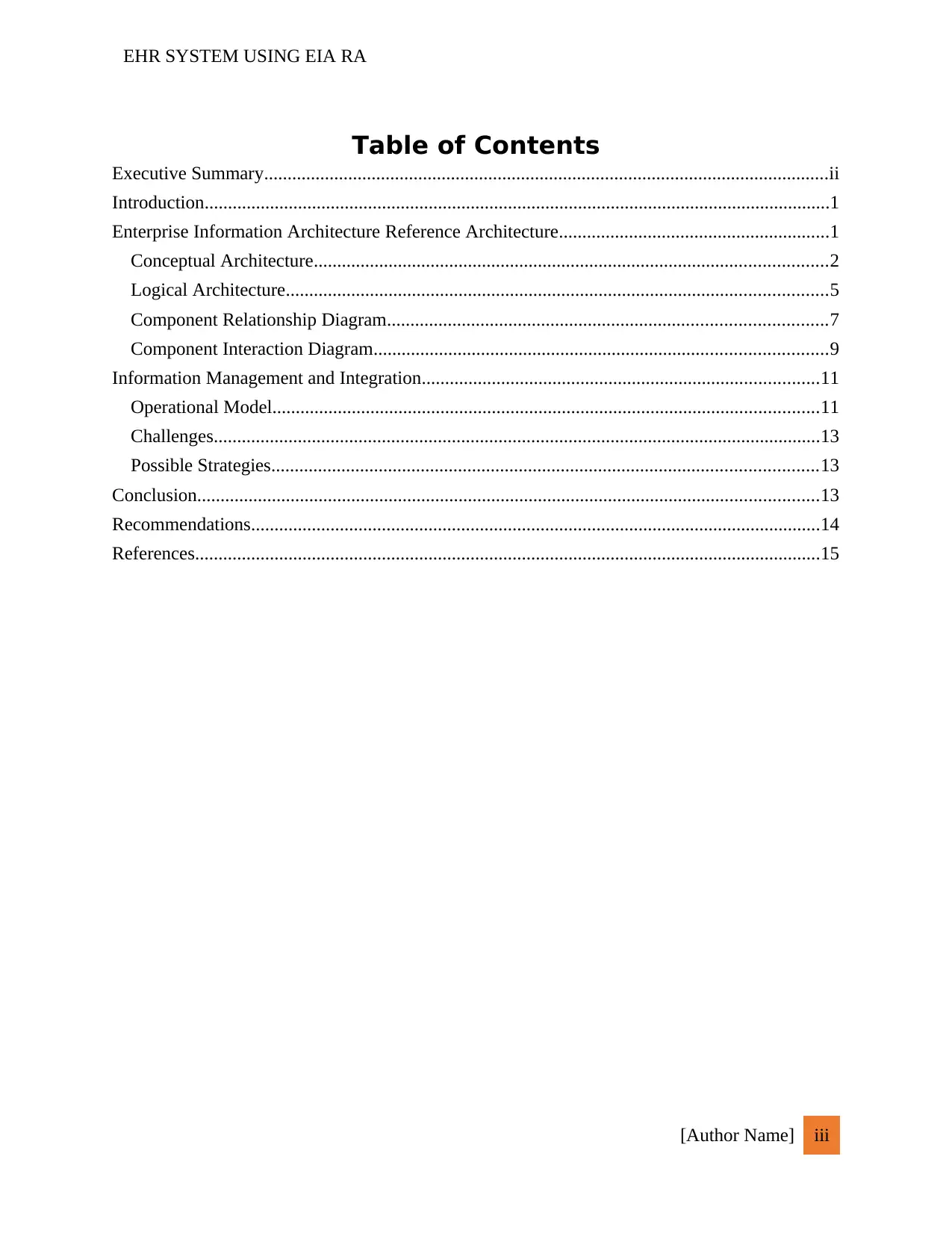
EHR SYSTEM USING EIA RA
Table of Contents
Executive Summary.........................................................................................................................ii
Introduction......................................................................................................................................1
Enterprise Information Architecture Reference Architecture..........................................................1
Conceptual Architecture..............................................................................................................2
Logical Architecture....................................................................................................................5
Component Relationship Diagram..............................................................................................7
Component Interaction Diagram.................................................................................................9
Information Management and Integration.....................................................................................11
Operational Model.....................................................................................................................11
Challenges..................................................................................................................................13
Possible Strategies.....................................................................................................................13
Conclusion.....................................................................................................................................13
Recommendations..........................................................................................................................14
References......................................................................................................................................15
[Author Name] iii
Table of Contents
Executive Summary.........................................................................................................................ii
Introduction......................................................................................................................................1
Enterprise Information Architecture Reference Architecture..........................................................1
Conceptual Architecture..............................................................................................................2
Logical Architecture....................................................................................................................5
Component Relationship Diagram..............................................................................................7
Component Interaction Diagram.................................................................................................9
Information Management and Integration.....................................................................................11
Operational Model.....................................................................................................................11
Challenges..................................................................................................................................13
Possible Strategies.....................................................................................................................13
Conclusion.....................................................................................................................................13
Recommendations..........................................................................................................................14
References......................................................................................................................................15
[Author Name] iii
⊘ This is a preview!⊘
Do you want full access?
Subscribe today to unlock all pages.

Trusted by 1+ million students worldwide
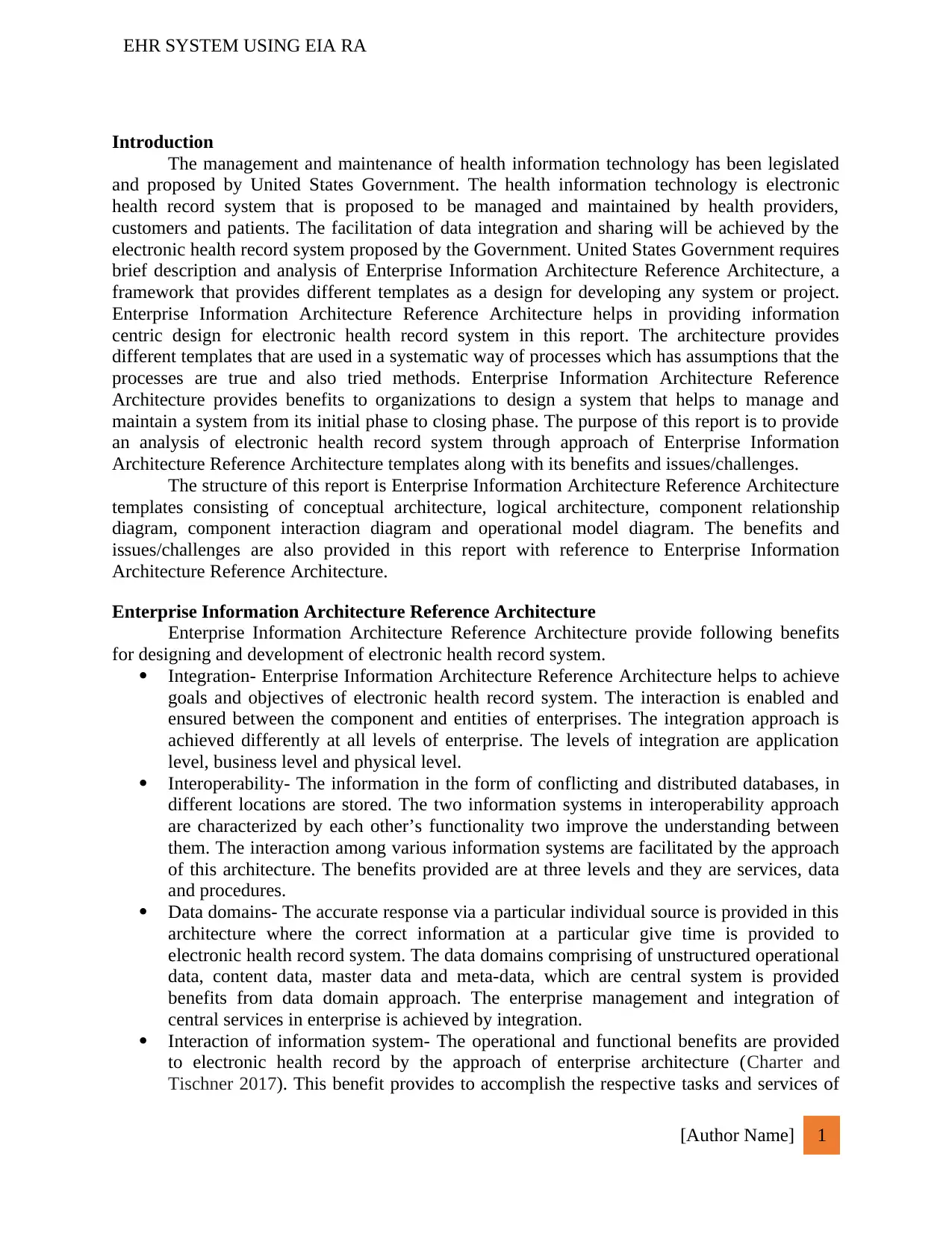
EHR SYSTEM USING EIA RA
Introduction
The management and maintenance of health information technology has been legislated
and proposed by United States Government. The health information technology is electronic
health record system that is proposed to be managed and maintained by health providers,
customers and patients. The facilitation of data integration and sharing will be achieved by the
electronic health record system proposed by the Government. United States Government requires
brief description and analysis of Enterprise Information Architecture Reference Architecture, a
framework that provides different templates as a design for developing any system or project.
Enterprise Information Architecture Reference Architecture helps in providing information
centric design for electronic health record system in this report. The architecture provides
different templates that are used in a systematic way of processes which has assumptions that the
processes are true and also tried methods. Enterprise Information Architecture Reference
Architecture provides benefits to organizations to design a system that helps to manage and
maintain a system from its initial phase to closing phase. The purpose of this report is to provide
an analysis of electronic health record system through approach of Enterprise Information
Architecture Reference Architecture templates along with its benefits and issues/challenges.
The structure of this report is Enterprise Information Architecture Reference Architecture
templates consisting of conceptual architecture, logical architecture, component relationship
diagram, component interaction diagram and operational model diagram. The benefits and
issues/challenges are also provided in this report with reference to Enterprise Information
Architecture Reference Architecture.
Enterprise Information Architecture Reference Architecture
Enterprise Information Architecture Reference Architecture provide following benefits
for designing and development of electronic health record system.
Integration- Enterprise Information Architecture Reference Architecture helps to achieve
goals and objectives of electronic health record system. The interaction is enabled and
ensured between the component and entities of enterprises. The integration approach is
achieved differently at all levels of enterprise. The levels of integration are application
level, business level and physical level.
Interoperability- The information in the form of conflicting and distributed databases, in
different locations are stored. The two information systems in interoperability approach
are characterized by each other’s functionality two improve the understanding between
them. The interaction among various information systems are facilitated by the approach
of this architecture. The benefits provided are at three levels and they are services, data
and procedures.
Data domains- The accurate response via a particular individual source is provided in this
architecture where the correct information at a particular give time is provided to
electronic health record system. The data domains comprising of unstructured operational
data, content data, master data and meta-data, which are central system is provided
benefits from data domain approach. The enterprise management and integration of
central services in enterprise is achieved by integration.
Interaction of information system- The operational and functional benefits are provided
to electronic health record by the approach of enterprise architecture (Charter and
Tischner 2017). This benefit provides to accomplish the respective tasks and services of
[Author Name] 1
Introduction
The management and maintenance of health information technology has been legislated
and proposed by United States Government. The health information technology is electronic
health record system that is proposed to be managed and maintained by health providers,
customers and patients. The facilitation of data integration and sharing will be achieved by the
electronic health record system proposed by the Government. United States Government requires
brief description and analysis of Enterprise Information Architecture Reference Architecture, a
framework that provides different templates as a design for developing any system or project.
Enterprise Information Architecture Reference Architecture helps in providing information
centric design for electronic health record system in this report. The architecture provides
different templates that are used in a systematic way of processes which has assumptions that the
processes are true and also tried methods. Enterprise Information Architecture Reference
Architecture provides benefits to organizations to design a system that helps to manage and
maintain a system from its initial phase to closing phase. The purpose of this report is to provide
an analysis of electronic health record system through approach of Enterprise Information
Architecture Reference Architecture templates along with its benefits and issues/challenges.
The structure of this report is Enterprise Information Architecture Reference Architecture
templates consisting of conceptual architecture, logical architecture, component relationship
diagram, component interaction diagram and operational model diagram. The benefits and
issues/challenges are also provided in this report with reference to Enterprise Information
Architecture Reference Architecture.
Enterprise Information Architecture Reference Architecture
Enterprise Information Architecture Reference Architecture provide following benefits
for designing and development of electronic health record system.
Integration- Enterprise Information Architecture Reference Architecture helps to achieve
goals and objectives of electronic health record system. The interaction is enabled and
ensured between the component and entities of enterprises. The integration approach is
achieved differently at all levels of enterprise. The levels of integration are application
level, business level and physical level.
Interoperability- The information in the form of conflicting and distributed databases, in
different locations are stored. The two information systems in interoperability approach
are characterized by each other’s functionality two improve the understanding between
them. The interaction among various information systems are facilitated by the approach
of this architecture. The benefits provided are at three levels and they are services, data
and procedures.
Data domains- The accurate response via a particular individual source is provided in this
architecture where the correct information at a particular give time is provided to
electronic health record system. The data domains comprising of unstructured operational
data, content data, master data and meta-data, which are central system is provided
benefits from data domain approach. The enterprise management and integration of
central services in enterprise is achieved by integration.
Interaction of information system- The operational and functional benefits are provided
to electronic health record by the approach of enterprise architecture (Charter and
Tischner 2017). This benefit provides to accomplish the respective tasks and services of
[Author Name] 1
Paraphrase This Document
Need a fresh take? Get an instant paraphrase of this document with our AI Paraphraser
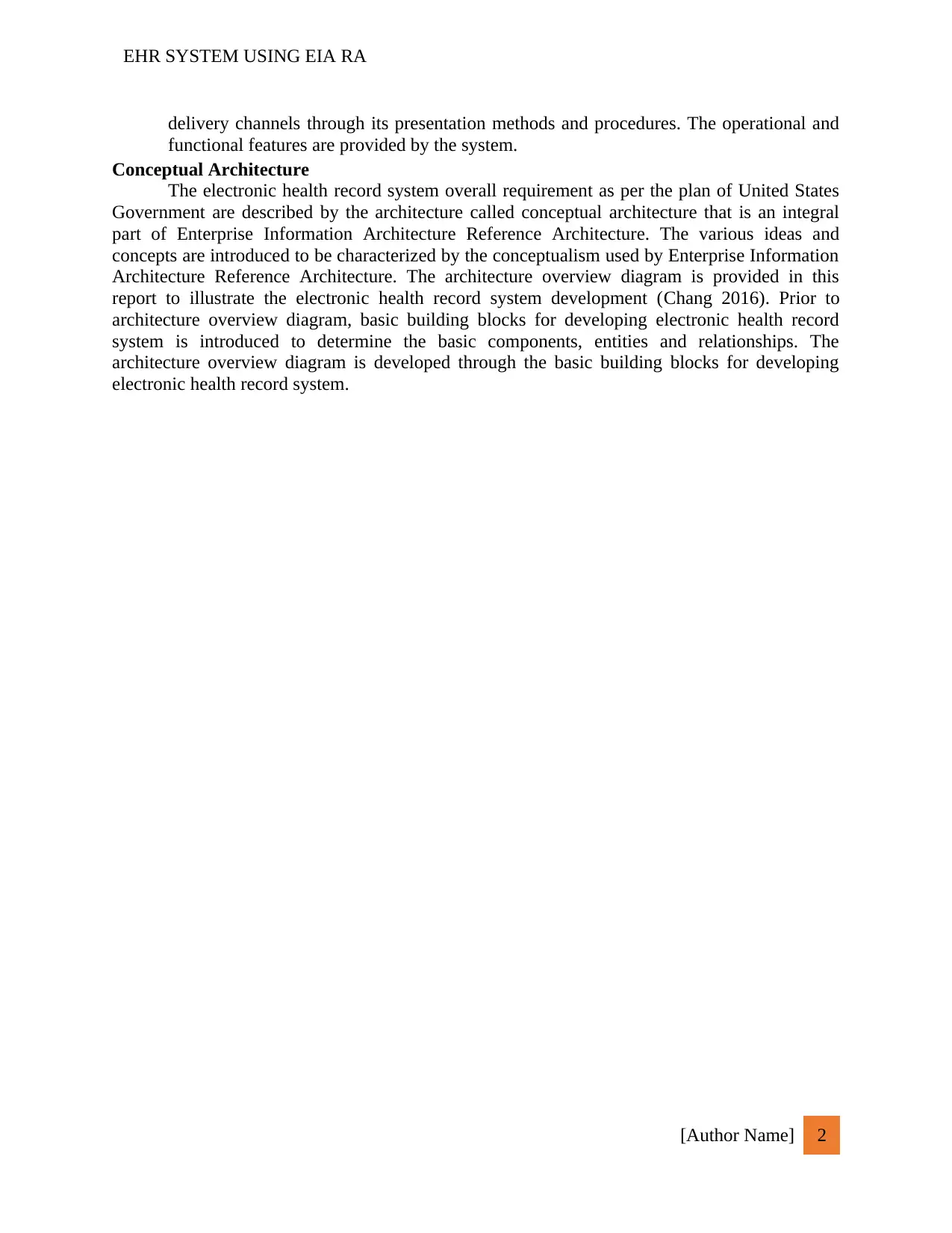
EHR SYSTEM USING EIA RA
delivery channels through its presentation methods and procedures. The operational and
functional features are provided by the system.
Conceptual Architecture
The electronic health record system overall requirement as per the plan of United States
Government are described by the architecture called conceptual architecture that is an integral
part of Enterprise Information Architecture Reference Architecture. The various ideas and
concepts are introduced to be characterized by the conceptualism used by Enterprise Information
Architecture Reference Architecture. The architecture overview diagram is provided in this
report to illustrate the electronic health record system development (Chang 2016). Prior to
architecture overview diagram, basic building blocks for developing electronic health record
system is introduced to determine the basic components, entities and relationships. The
architecture overview diagram is developed through the basic building blocks for developing
electronic health record system.
[Author Name] 2
delivery channels through its presentation methods and procedures. The operational and
functional features are provided by the system.
Conceptual Architecture
The electronic health record system overall requirement as per the plan of United States
Government are described by the architecture called conceptual architecture that is an integral
part of Enterprise Information Architecture Reference Architecture. The various ideas and
concepts are introduced to be characterized by the conceptualism used by Enterprise Information
Architecture Reference Architecture. The architecture overview diagram is provided in this
report to illustrate the electronic health record system development (Chang 2016). Prior to
architecture overview diagram, basic building blocks for developing electronic health record
system is introduced to determine the basic components, entities and relationships. The
architecture overview diagram is developed through the basic building blocks for developing
electronic health record system.
[Author Name] 2
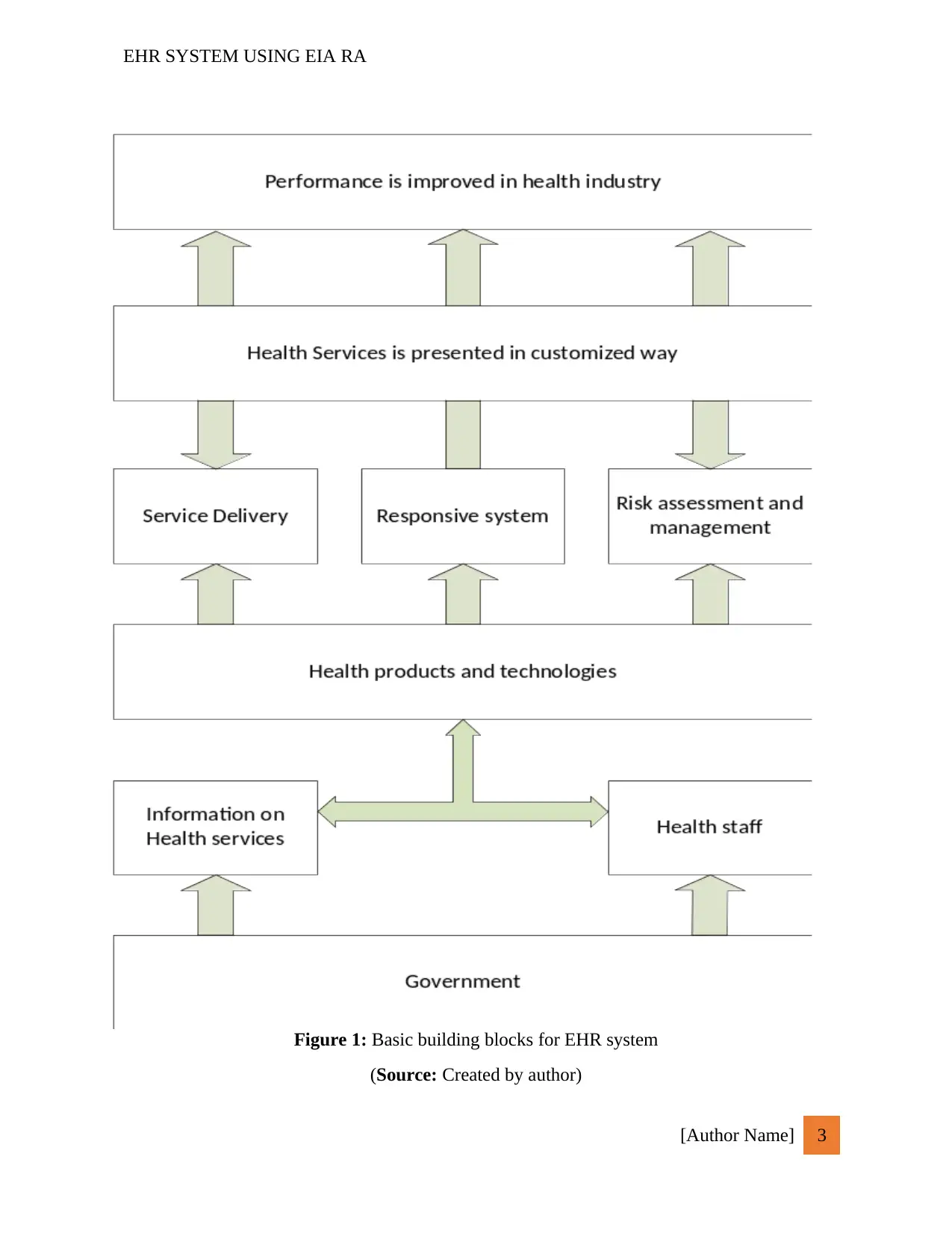
EHR SYSTEM USING EIA RA
Figure 1: Basic building blocks for EHR system
(Source: Created by author)
[Author Name] 3
Figure 1: Basic building blocks for EHR system
(Source: Created by author)
[Author Name] 3
⊘ This is a preview!⊘
Do you want full access?
Subscribe today to unlock all pages.

Trusted by 1+ million students worldwide
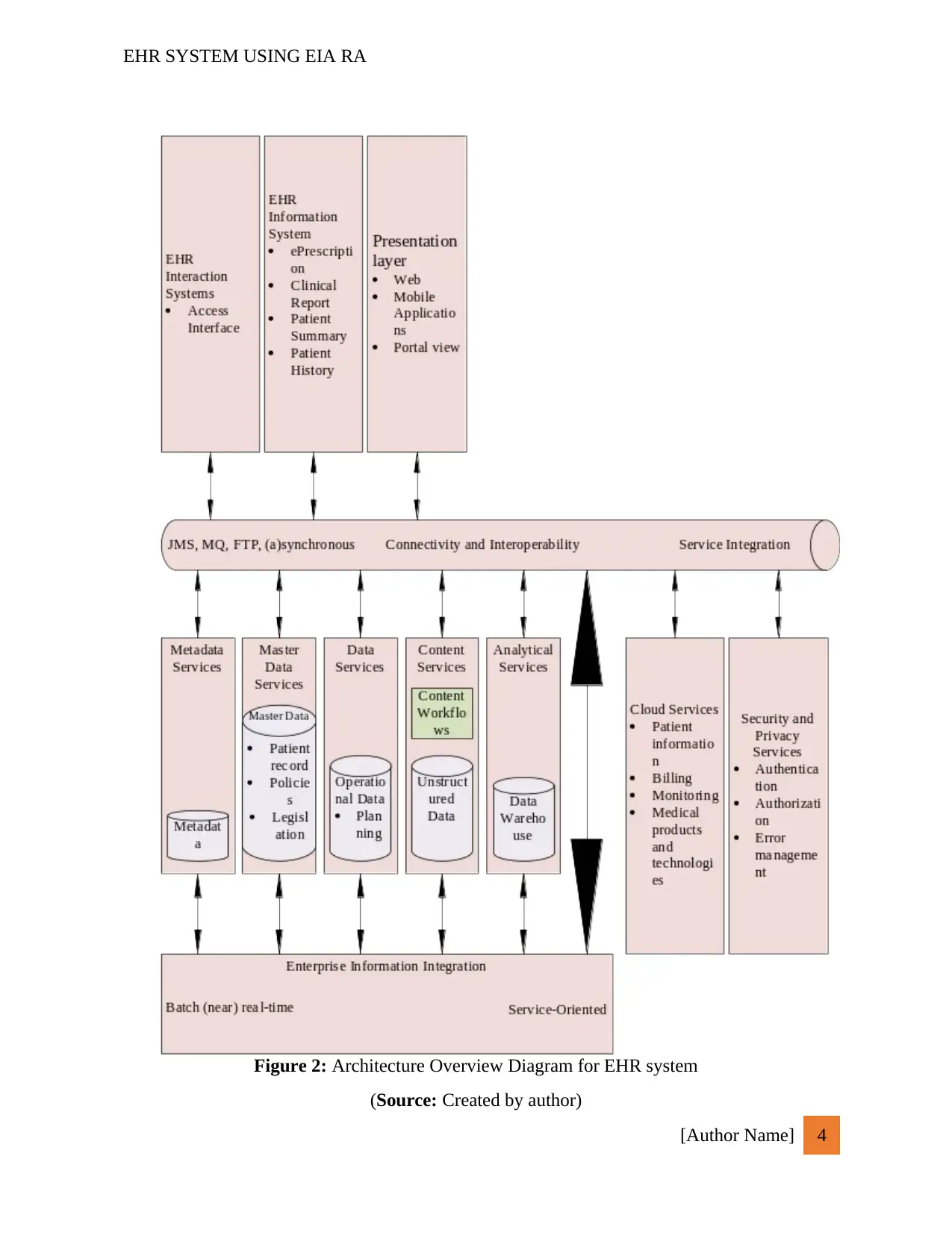
EHR SYSTEM USING EIA RA
Figure 2: Architecture Overview Diagram for EHR system
(Source: Created by author)
[Author Name] 4
Figure 2: Architecture Overview Diagram for EHR system
(Source: Created by author)
[Author Name] 4
Paraphrase This Document
Need a fresh take? Get an instant paraphrase of this document with our AI Paraphraser
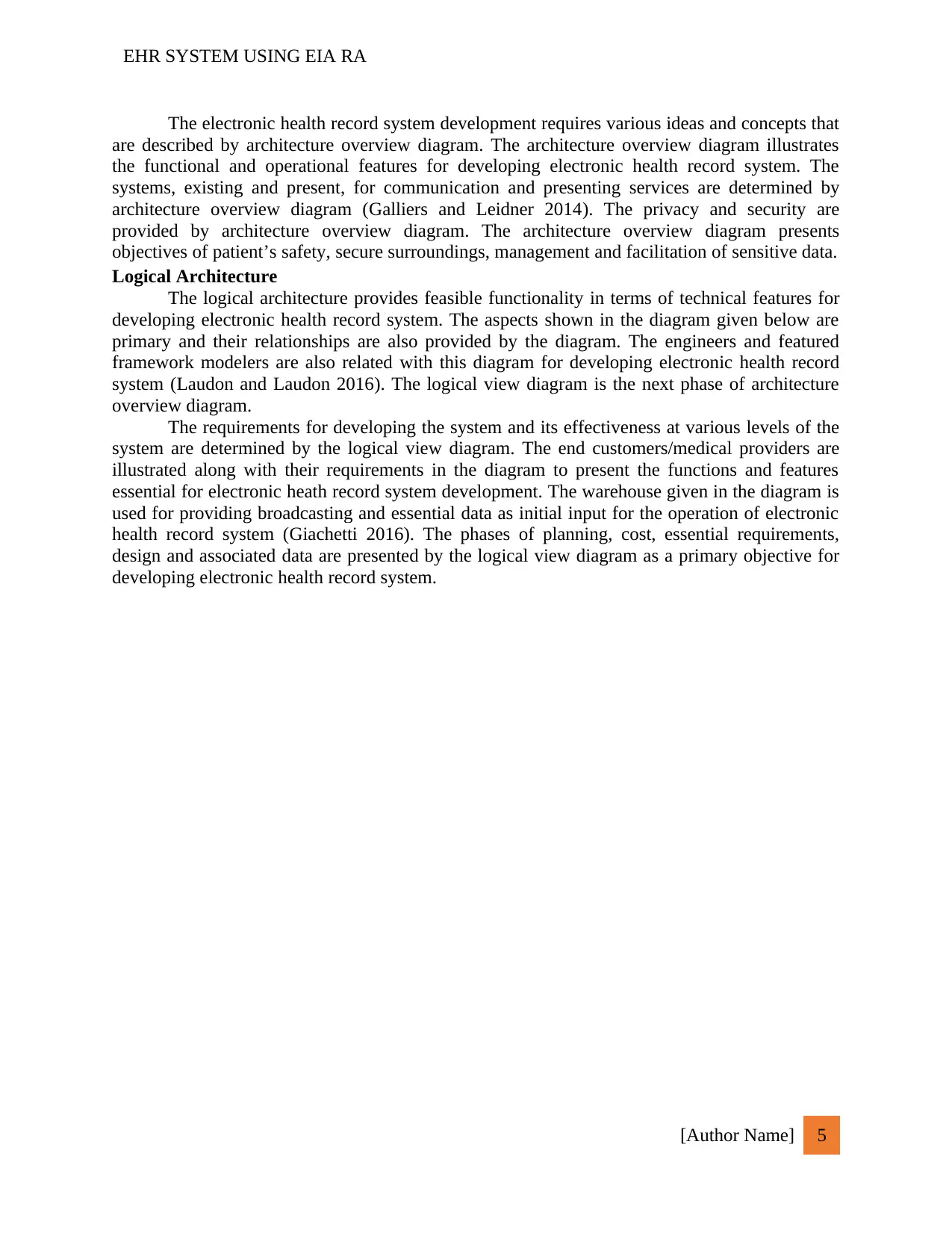
EHR SYSTEM USING EIA RA
The electronic health record system development requires various ideas and concepts that
are described by architecture overview diagram. The architecture overview diagram illustrates
the functional and operational features for developing electronic health record system. The
systems, existing and present, for communication and presenting services are determined by
architecture overview diagram (Galliers and Leidner 2014). The privacy and security are
provided by architecture overview diagram. The architecture overview diagram presents
objectives of patient’s safety, secure surroundings, management and facilitation of sensitive data.
Logical Architecture
The logical architecture provides feasible functionality in terms of technical features for
developing electronic health record system. The aspects shown in the diagram given below are
primary and their relationships are also provided by the diagram. The engineers and featured
framework modelers are also related with this diagram for developing electronic health record
system (Laudon and Laudon 2016). The logical view diagram is the next phase of architecture
overview diagram.
The requirements for developing the system and its effectiveness at various levels of the
system are determined by the logical view diagram. The end customers/medical providers are
illustrated along with their requirements in the diagram to present the functions and features
essential for electronic heath record system development. The warehouse given in the diagram is
used for providing broadcasting and essential data as initial input for the operation of electronic
health record system (Giachetti 2016). The phases of planning, cost, essential requirements,
design and associated data are presented by the logical view diagram as a primary objective for
developing electronic health record system.
[Author Name] 5
The electronic health record system development requires various ideas and concepts that
are described by architecture overview diagram. The architecture overview diagram illustrates
the functional and operational features for developing electronic health record system. The
systems, existing and present, for communication and presenting services are determined by
architecture overview diagram (Galliers and Leidner 2014). The privacy and security are
provided by architecture overview diagram. The architecture overview diagram presents
objectives of patient’s safety, secure surroundings, management and facilitation of sensitive data.
Logical Architecture
The logical architecture provides feasible functionality in terms of technical features for
developing electronic health record system. The aspects shown in the diagram given below are
primary and their relationships are also provided by the diagram. The engineers and featured
framework modelers are also related with this diagram for developing electronic health record
system (Laudon and Laudon 2016). The logical view diagram is the next phase of architecture
overview diagram.
The requirements for developing the system and its effectiveness at various levels of the
system are determined by the logical view diagram. The end customers/medical providers are
illustrated along with their requirements in the diagram to present the functions and features
essential for electronic heath record system development. The warehouse given in the diagram is
used for providing broadcasting and essential data as initial input for the operation of electronic
health record system (Giachetti 2016). The phases of planning, cost, essential requirements,
design and associated data are presented by the logical view diagram as a primary objective for
developing electronic health record system.
[Author Name] 5
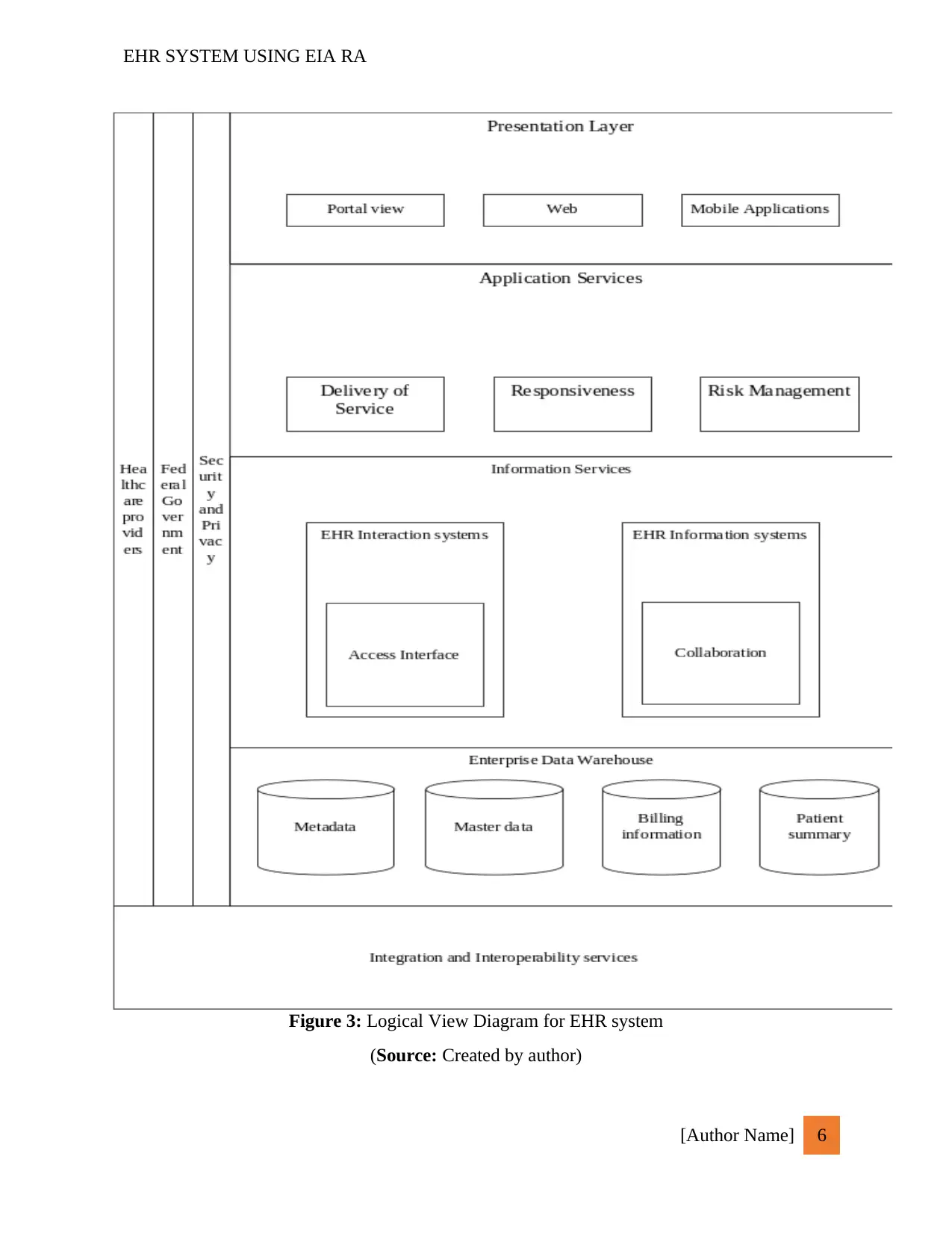
EHR SYSTEM USING EIA RA
Figure 3: Logical View Diagram for EHR system
(Source: Created by author)
[Author Name] 6
Figure 3: Logical View Diagram for EHR system
(Source: Created by author)
[Author Name] 6
⊘ This is a preview!⊘
Do you want full access?
Subscribe today to unlock all pages.

Trusted by 1+ million students worldwide
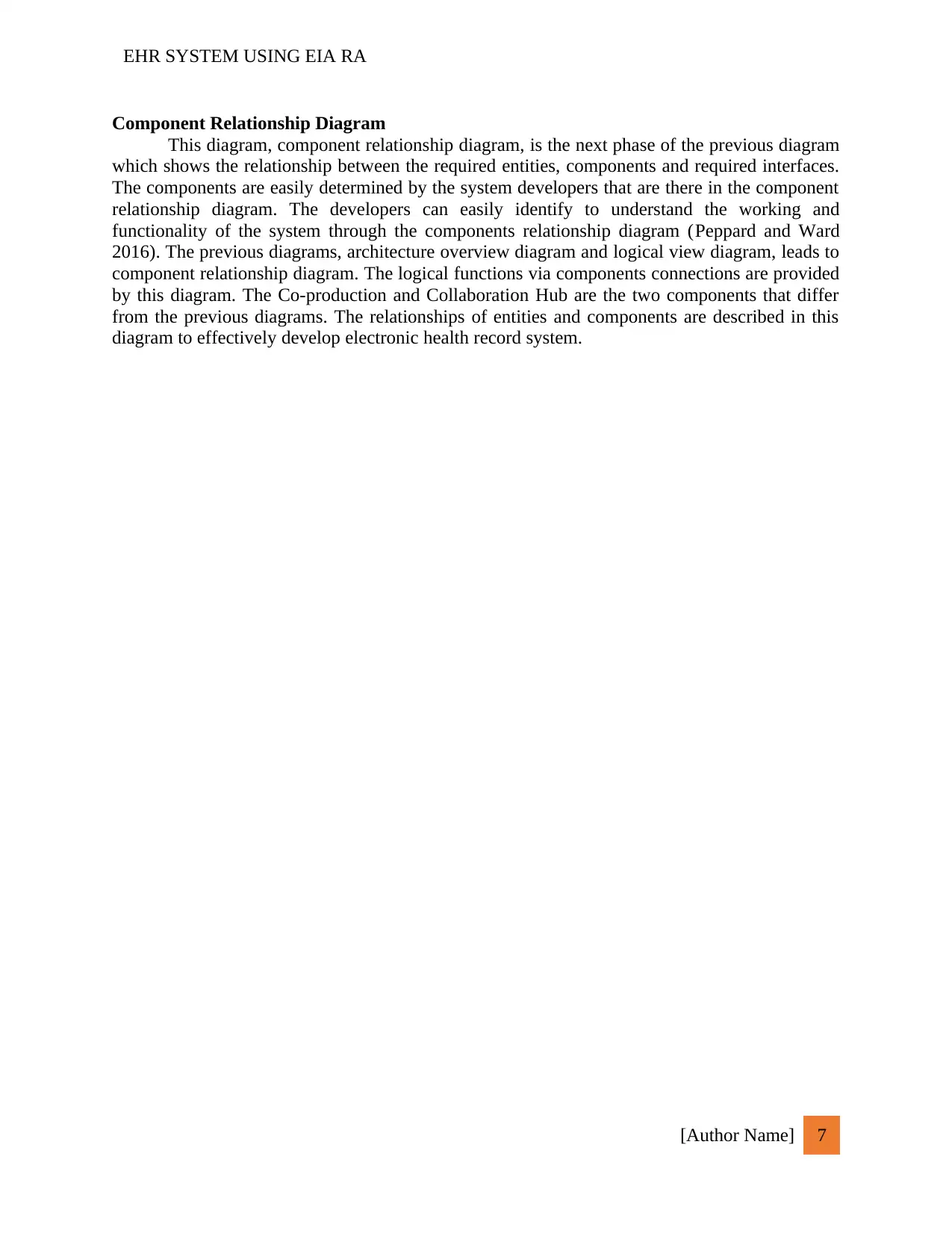
EHR SYSTEM USING EIA RA
Component Relationship Diagram
This diagram, component relationship diagram, is the next phase of the previous diagram
which shows the relationship between the required entities, components and required interfaces.
The components are easily determined by the system developers that are there in the component
relationship diagram. The developers can easily identify to understand the working and
functionality of the system through the components relationship diagram (Peppard and Ward
2016). The previous diagrams, architecture overview diagram and logical view diagram, leads to
component relationship diagram. The logical functions via components connections are provided
by this diagram. The Co-production and Collaboration Hub are the two components that differ
from the previous diagrams. The relationships of entities and components are described in this
diagram to effectively develop electronic health record system.
[Author Name] 7
Component Relationship Diagram
This diagram, component relationship diagram, is the next phase of the previous diagram
which shows the relationship between the required entities, components and required interfaces.
The components are easily determined by the system developers that are there in the component
relationship diagram. The developers can easily identify to understand the working and
functionality of the system through the components relationship diagram (Peppard and Ward
2016). The previous diagrams, architecture overview diagram and logical view diagram, leads to
component relationship diagram. The logical functions via components connections are provided
by this diagram. The Co-production and Collaboration Hub are the two components that differ
from the previous diagrams. The relationships of entities and components are described in this
diagram to effectively develop electronic health record system.
[Author Name] 7
Paraphrase This Document
Need a fresh take? Get an instant paraphrase of this document with our AI Paraphraser
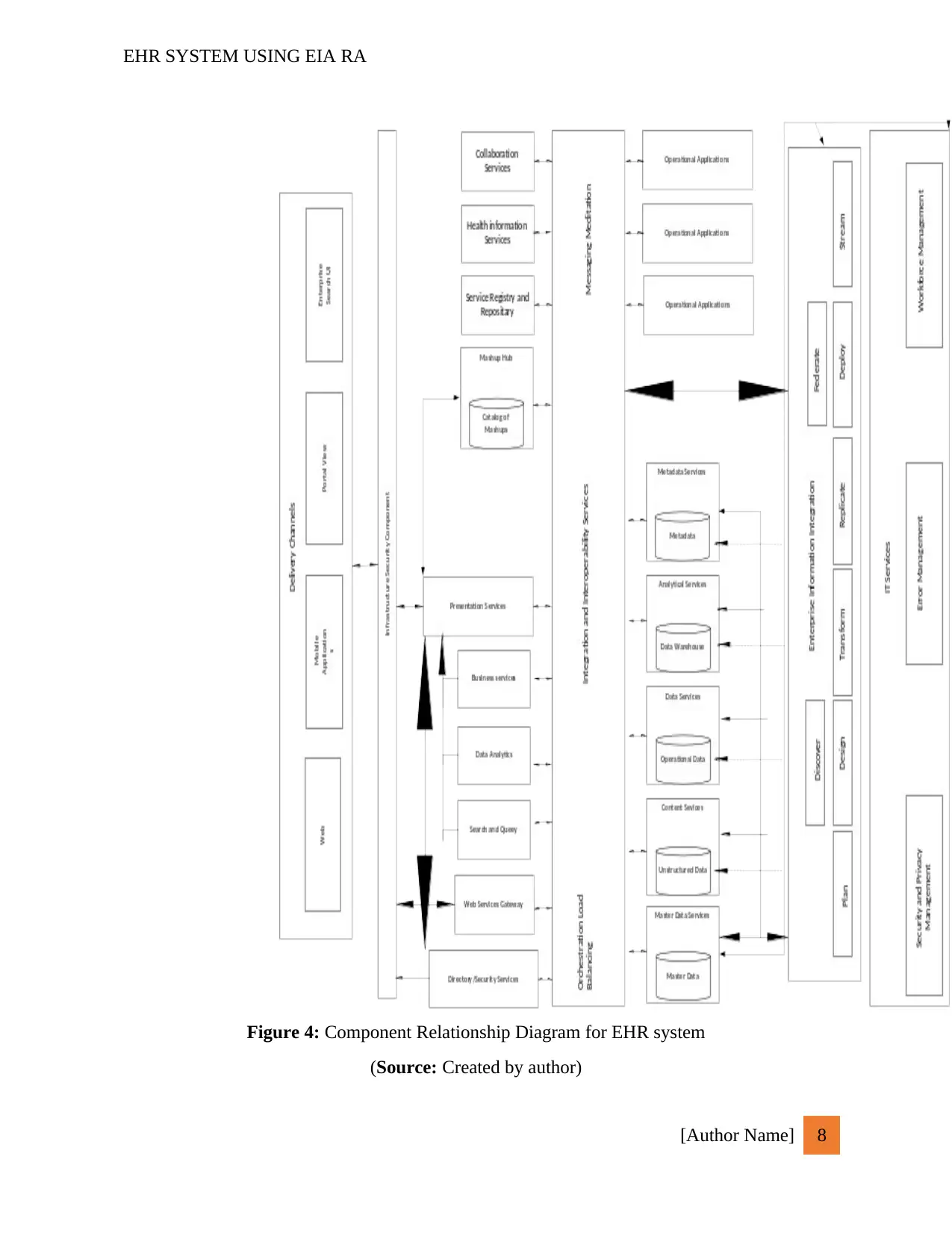
EHR SYSTEM USING EIA RA
Figure 4: Component Relationship Diagram for EHR system
(Source: Created by author)
[Author Name] 8
Figure 4: Component Relationship Diagram for EHR system
(Source: Created by author)
[Author Name] 8
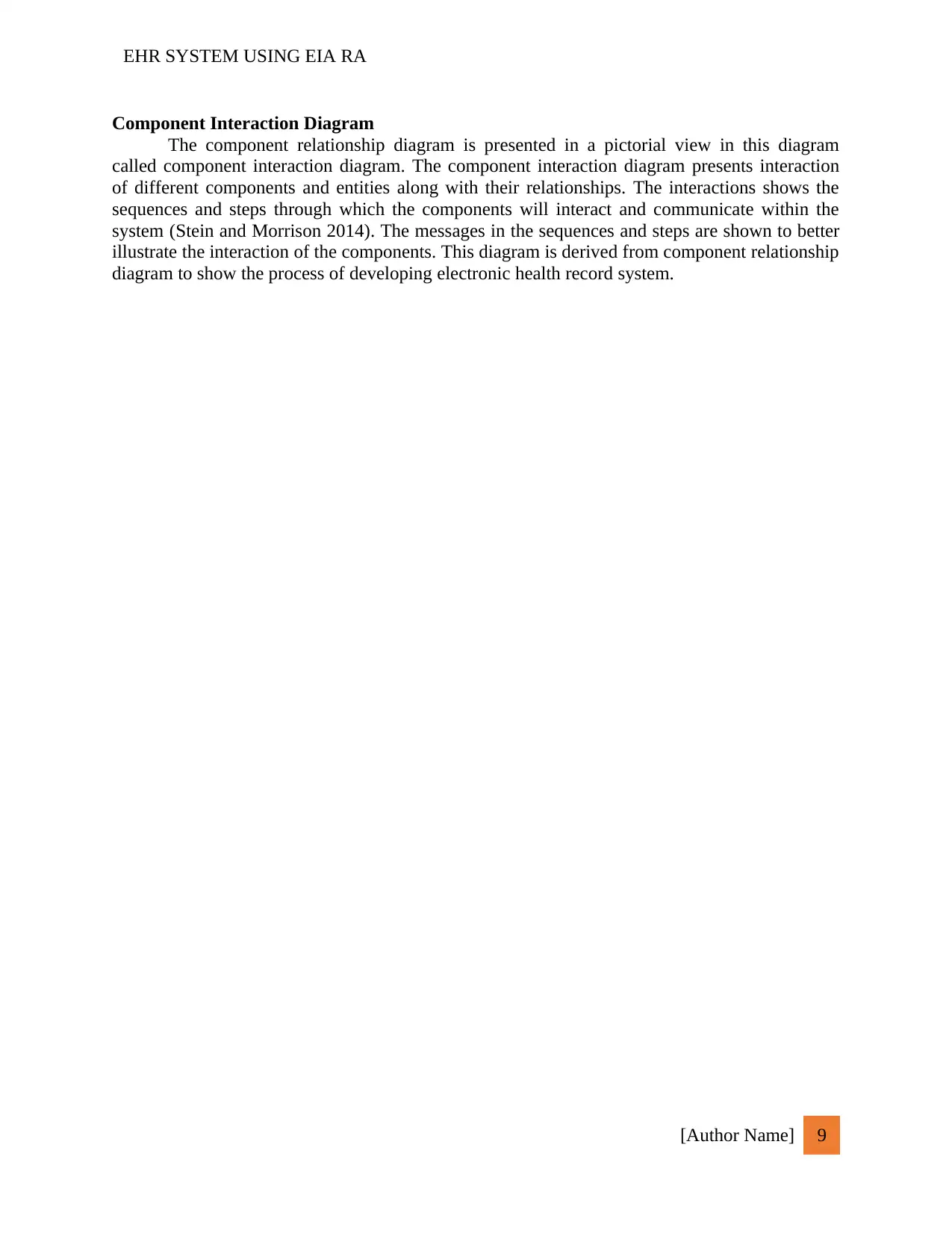
EHR SYSTEM USING EIA RA
Component Interaction Diagram
The component relationship diagram is presented in a pictorial view in this diagram
called component interaction diagram. The component interaction diagram presents interaction
of different components and entities along with their relationships. The interactions shows the
sequences and steps through which the components will interact and communicate within the
system (Stein and Morrison 2014). The messages in the sequences and steps are shown to better
illustrate the interaction of the components. This diagram is derived from component relationship
diagram to show the process of developing electronic health record system.
[Author Name] 9
Component Interaction Diagram
The component relationship diagram is presented in a pictorial view in this diagram
called component interaction diagram. The component interaction diagram presents interaction
of different components and entities along with their relationships. The interactions shows the
sequences and steps through which the components will interact and communicate within the
system (Stein and Morrison 2014). The messages in the sequences and steps are shown to better
illustrate the interaction of the components. This diagram is derived from component relationship
diagram to show the process of developing electronic health record system.
[Author Name] 9
⊘ This is a preview!⊘
Do you want full access?
Subscribe today to unlock all pages.

Trusted by 1+ million students worldwide
1 out of 19
Related Documents
Your All-in-One AI-Powered Toolkit for Academic Success.
+13062052269
info@desklib.com
Available 24*7 on WhatsApp / Email
![[object Object]](/_next/static/media/star-bottom.7253800d.svg)
Unlock your academic potential
Copyright © 2020–2025 A2Z Services. All Rights Reserved. Developed and managed by ZUCOL.




